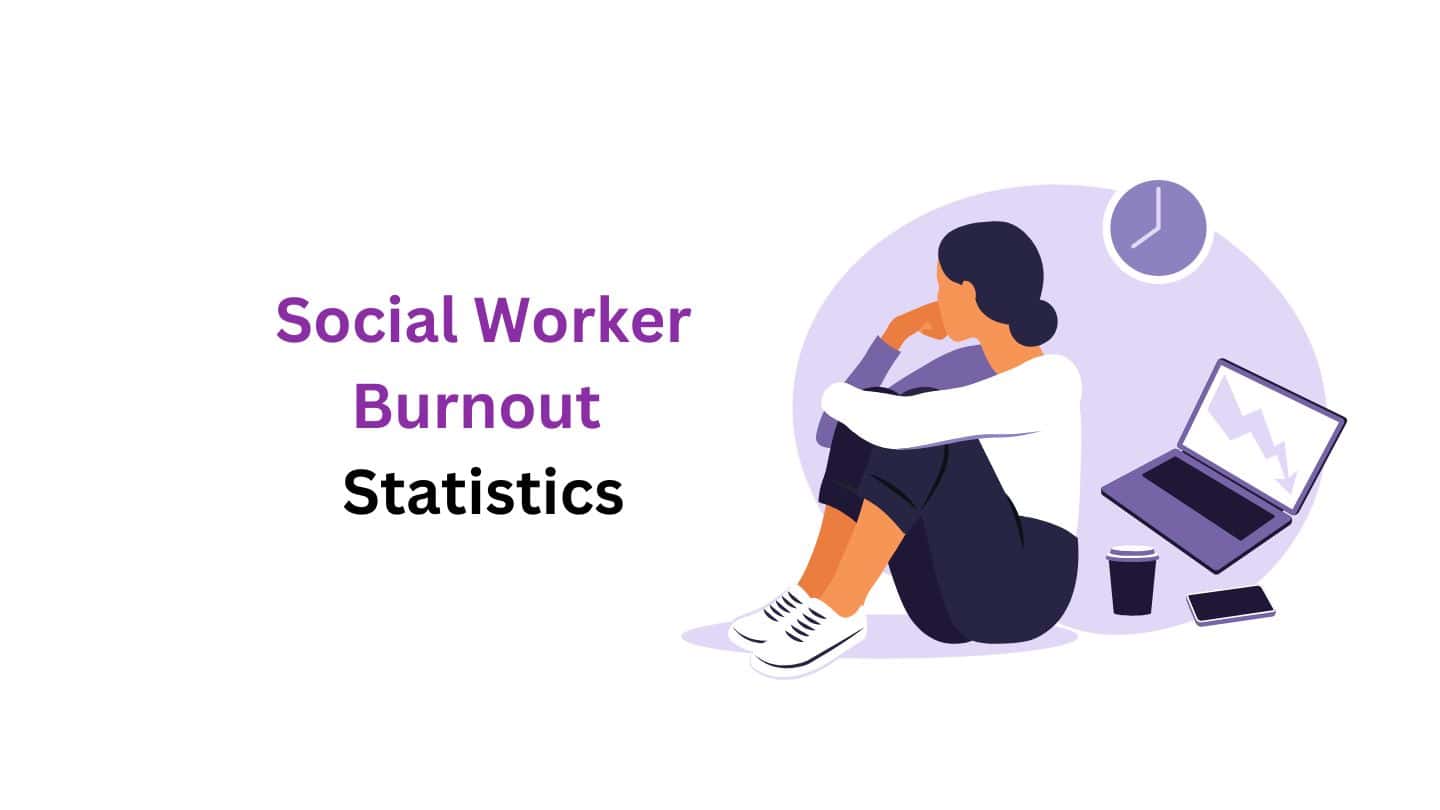Social Worker Burnout Statistics By Mental Health, Impacts, Demographics and Facts

Updated · Feb 28, 2025


TABLE OF CONTENTS
Introduction
Social Worker Burnout Statistics: Social workers are hardworking and caring professionals who help people in need. However, their job can be emotionally and mentally exhausting, which can lead to burnout. Burnout is a condition where someone feels physically, emotionally, and mentally drained due to constant stress and high job demands. The first step to dealing with burnout is recognizing its signs. These include feeling tired, disconnected, or negative about work and clients.
Physical symptoms, such as headaches, stomach aches, and trouble sleeping, can also appear. To avoid burnout, taking care of yourself is very important. This can mean taking regular breaks, talking to colleagues or supervisors for support, and doing things you enjoy outside of work. Burnout is not just a personal issue but also a problem for the entire organization, as it affects the quality of care for vulnerable people. The Social Worker Burnout Statistics will shed more light on this topic.
Editor’s Choice
- Social Worker Burnout Statistics stated that almost 75% of social workers have faced burnout at some point in their careers.
- During the COVID-19 pandemic, 41.2% of social workers said they experienced serious burnout.
- Another survey revealed that about 67% of social workers have thought about leaving their jobs because of burnout.
- 7% of social workers said their mental health has gotten worse due to their work.
- Child welfare social workers experience particularly high burnout rates. One study found that 70% of social workers dealing with children’s cases struggle with heavy workloads and burnout.
- Healthcare social workers also deal with a lot of burnout, with 43% reporting symptoms.
- A study in the UK looked at burnout among different groups of social workers and found that those working with certain populations had higher emotional exhaustion.
- During the COVID-19 pandemic, 58.5% of social workers thought about changing jobs, and 40% even considered leaving the social work field completely.
- Social Worker Burnout Statistics stated that 72.5% of social workers in the UK did not work from home.
- In Singapore, nearly 63% of social workers said they struggled with anxiety and depression, with 50% experiencing depression during the COVID-19 pandemic.
- Social workers in family services typically handle an average of 22 cases.
- Social Worker Burnout Statistics stated that the food service and hospitality industries had the highest burnout rates globally, with 80% of workers feeling overwhelmed. The healthcare industry also had a high burnout rate, with 76% of workers affected.
- In Spain, 20.4% of social workers faced burnout during the COVID-19 pandemic. Among them, 70.1% felt emotionally drained, 48.5% experienced detachment from their work, and 36% felt a loss of personal accomplishment.
- In the U.S., 63.71% of social workers experienced burnout during the pandemic, and 49.59% reported experiencing secondary trauma.
- Half (50%) of child welfare social workers reported high burnout levels, mostly due to a lack of support.
- 1% of surveyed social workers said they are currently experiencing burnout in their work.
- Social Worker Burnout Statistics stated that nearly 66% of social workers in traditional schools have considered leaving the profession because of burnout.
- 2% of social workers said that recognition from their peers helps reduce their burnout.
What is Social Worker Burnout?
Burnout in social work isn’t just about being tired after a long day. It’s a deep feeling of physical, emotional, and mental exhaustion that builds up over time. You might start feeling:
- Overwhelmed with your workload
- Losing interest in your job
- Having trouble connecting with your clients
- Questioning if you’re really making a difference
Burnout can gradually affect both your work and personal life, but the good news is that recognizing these signs is the first step in fixing them.
The term “burnout” was first used in the 1970s to describe stress from work relationships. For social workers, it often shows as a slow loss of energy, enthusiasm, and purpose.
It’s important to understand that burnout isn’t a failure. It’s a normal response to long-term stress, especially when you feel like your hard work isn’t having the impact you hoped for.
As a case manager, child welfare worker, or police social worker, you’re especially vulnerable because your job can be emotionally tough, and the needs of your clients are often overwhelming.
General Social Worker Burnout Statistics
- Social workers who felt overwhelmed by more work pressures experienced higher levels of burnout than those who felt a little affected or not affected at all. (Source)
- The main signs of burnout are emotional exhaustion, feeling detached from others, and a lack of personal accomplishment.
- Social workers working on the front lines during the pandemic, who lost more patients and had little support, reported higher burnout, sadness, and anxiety.
- At the start of the COVID-19 pandemic, about 26.21% of social workers began to develop PTSD.
- A year after the pandemic, 41.2% of social workers said they were dealing with severe burnout.
- 41% of social workers reported feeling emotionally drained in the past year.
- In Germany, 23% of social workers said their job caused them emotional stress.
- Social Worker Burnout Statistics stated that almost 41% of social workers often felt emotionally exhausted.
- Almost 58% of child welfare social workers said their workload was too heavy.
- 55% of social workers felt like they were asked to do too many tasks.
- In Australia, 50% of social workers on the front lines and 60% of leaders felt drained and overwhelmed due to understaffing and lack of government funding.
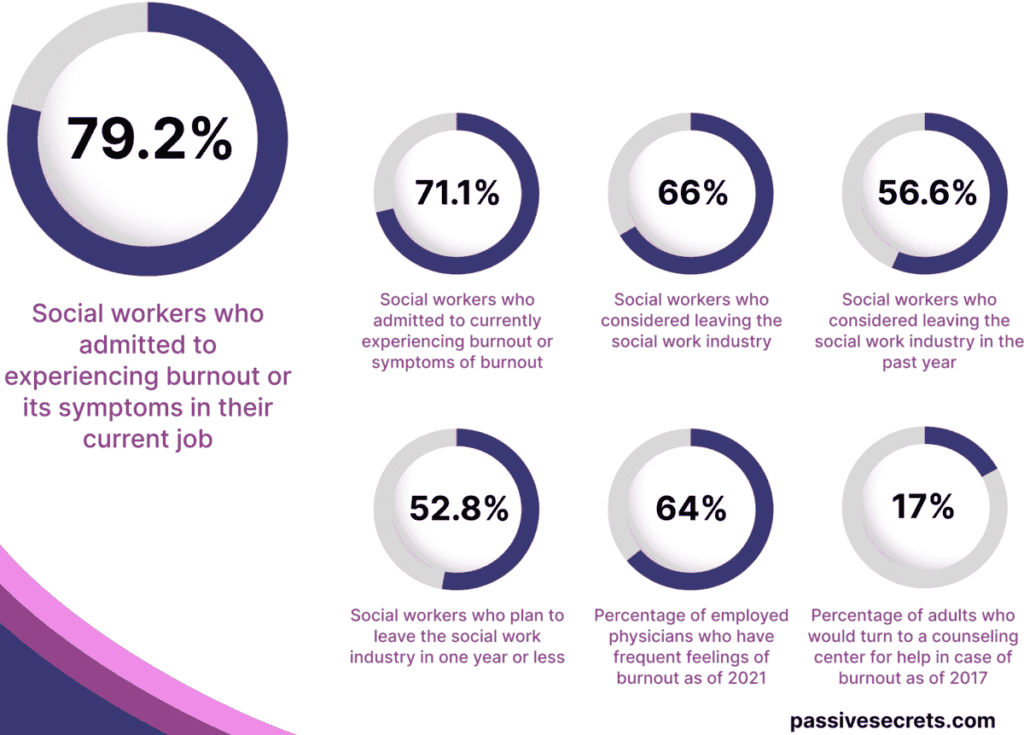 (Source: passivesecrets.com)
(Source: passivesecrets.com)
- 54% of social work organizations said increasing demand and more complex cases were adding pressure on staff, causing burnout and affecting service quality.
- 81% of social workers in domestic violence services admitted to feeling emotionally drained.
- Social Worker Burnout Statistics stated that almost 30% of social work organizations had to send clients to other places because they didn’t have enough resources.
- Lack of funding is one of the main reasons for social worker burnout, making it hard for organizations to hire and keep staff.
- Social workers who emailed more during the pandemic experienced higher burnout and felt less personal achievement.
- Social workers who were more satisfied with their jobs reported lower burnout levels.
- More social workers (69.4%) feel overwhelmed compared to other health and care workers.
- After the pandemic, social workers are more likely to use substances, blame themselves, or disconnect from work as ways to cope.
- Social Worker Burnout Statistics stated that social workers’ work quality decreased during the pandemic.
- The turnover rate for frontline social workers is between 30% and 50% every year.
- The social work industry is expected to grow by 12% between 2020 and 2030, which means about 78,300 job openings every year.
Factors Causing Social Worker Burnout
- Client needs are becoming more complicated.
- The youth mental health crisis is affecting many areas.
- The work is stressful and demanding.
- Social workers are still feeling the impact of COVID-19.
- New staff members are dealing with heavy caseloads.
- Workers lack important resources and support.
- Jobs offer little flexibility, and pay is low.
- There aren’t enough qualified workers to fill open roles.
- Too much time is spent on paperwork.
- There’s not enough time to make a real difference for clients.
Deteriorating Mental Health Statistics
- 7% of the respondents said their mental health had worsened recently because of their work, and another 9.6% said their mental health had completely “collapsed.”
- In total, 86.2% of the respondents mentioned that their job caused them significant stress.
- When asked why, many said their workloads and caseloads were to blame, including the administrative tasks they had to do and the pressure to meet tight deadlines.
- Staffing shortages were also a major concern.
- As a result, some social workers were working unpaid overtime to finish their tasks, while others felt they were letting people down by not being able to do their jobs as they wanted.
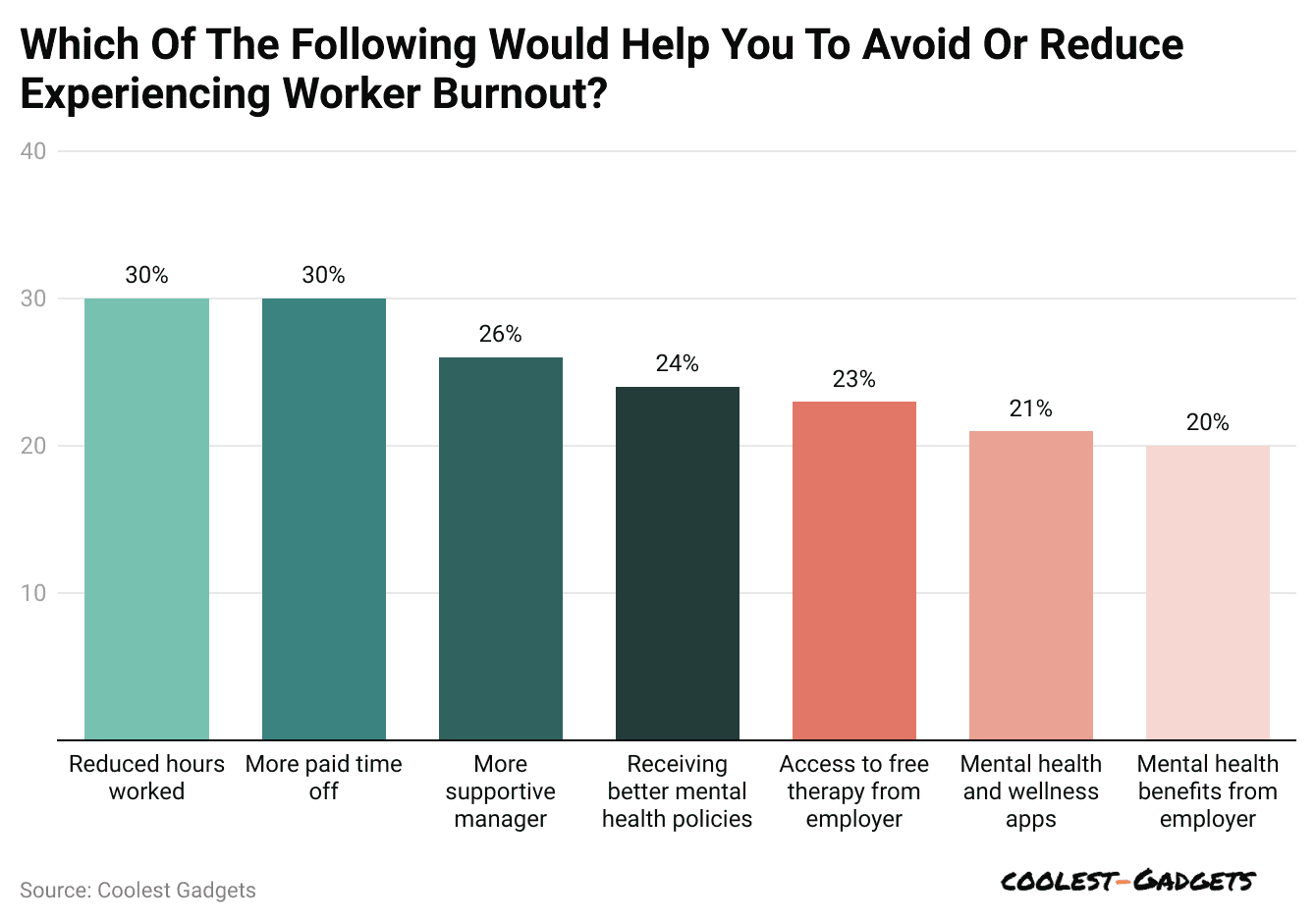 (Reference: prnewswire.com)
(Reference: prnewswire.com)
- This concern was also reflected in other survey answers.
- Social Worker Burnout Statistics stated that about 60% of social workers said they were either completely (21%) or partially (39%) unable to perform their jobs to the standard they wanted.
- Also, 58% of respondents said their caseload was either unmanageable or only partially manageable.
- Most social workers expected the situation to get worse in the next year.
- Around 86.3% of them predicted a significant (51.5%) or slight (34.9%) increase in the number of referrals and assessments they would have to handle.
- Some social workers also mentioned feeling pressure, a lack of understanding, and, in some cases, bullying from management as additional sources of stress.
Impact of Social Worker Burnout on the Community
Burnout and the high turnover of staff don’t only affect social workers and case managers – they cause problems for the whole agency and the communities they serve. Here’s how this cycle of issues unfolds:
- Social Worker Burnout: Social workers become mentally, emotionally, and physically exhausted, needing more support to keep going.
- High Staff Turnover: Without enough resources or help, social workers feel they can’t do their jobs well and decide to leave the field.
- Overwhelming Caseloads: The remaining workers are overloaded and don’t have enough time, tools, or information to manage tough cases, which keeps the agency involved for longer.
- Worse Outcomes for Families: Families don’t get the proper help, and the disruption in their case management makes it harder to find long-term solutions.
- Higher Agency Costs: The agency faces rising costs for things like overtime, hiring, and training new staff, as well as the longer stays of children in care.
- Mission at Risk: The pressure and time spent just trying to stay afloat stop the agency from fulfilling its purpose and providing quality services efficiently.
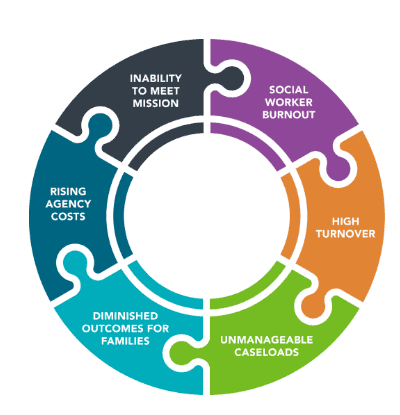 (Source: teamnorthwoods.com)
(Source: teamnorthwoods.com)
Impact on Workers:
- Workers who remain end up with even more cases, which makes their stress worse.
- Employee morale drops as workers feel overburdened.
- Finding a balance between work and personal life becomes almost impossible.
- Supervisors spend more time filling in for others and solving problems rather than guiding and supporting their team.
Impact on Clients:
- Families don’t get the help they need, and it takes longer to get services started.
- Cases take longer to resolve, so children stay in the system for more time.
- Clients have to tell their stories over and over to different workers, which can be re-traumatizing.
- Families may become less committed to improving their situations and outcomes.
Impact on the Agency:
- There’s a higher risk of legal and financial issues as workers struggle to meet their duties.
- It costs more to care for children longer.
- It’s expensive and difficult to improve services when new workers need continuous training.
- Failing to deliver quality services leads to a loss of trust and support from the community.
Impact on the Profession:
- Fewer people are entering or staying in social work.
- Social work is viewed as a temporary job rather than a long-term career.
- Social workers aren’t seen as essential professionals because of the constant turnover.
Social Worker Demographics Statistics
- Social Worker Burnout Statistics stated that emotional exhaustion is common, with 70.1% of social workers saying they feel very tired emotionally.
- About 48.5% experience depersonalization, which means feeling disconnected or detached from their work. However, fewer workers (36.6%) reported feeling a lower sense of personal accomplishment.
- The overall burnout rate is 20.4%, which is lower than the emotional exhaustion and depersonalization rates.
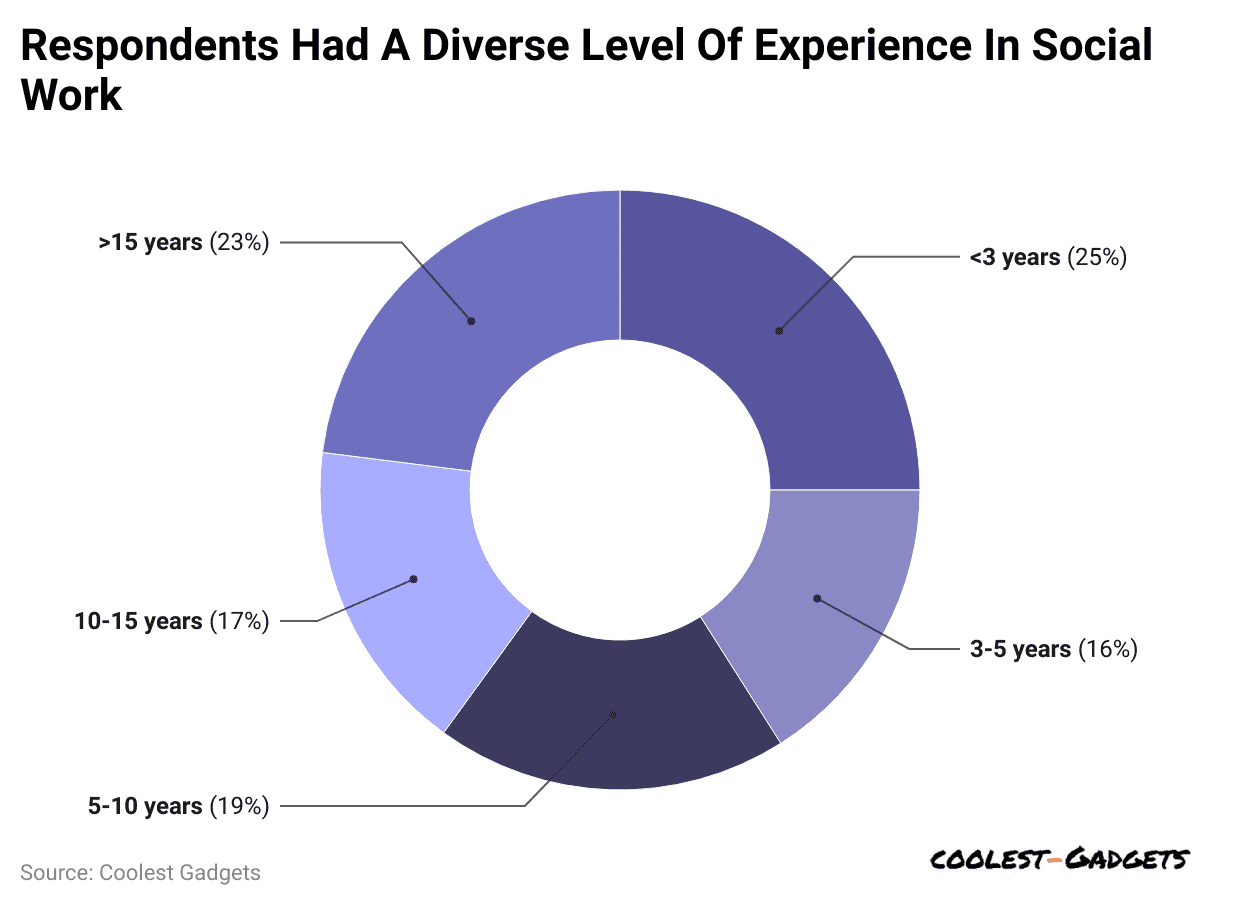 (Reference: agentsofchangeprep.com)
(Reference: agentsofchangeprep.com)
- Social Worker Burnout Statistics stated that working from home and getting psychological help are key factors related to feeling emotionally drained.
- For depersonalization, being between 41 and 50 years old and anticipating the need for future mental health support were linked to higher levels of detachment.
- In terms of roles, most participants (62%) were frontline social workers, while 24% held senior social worker positions.
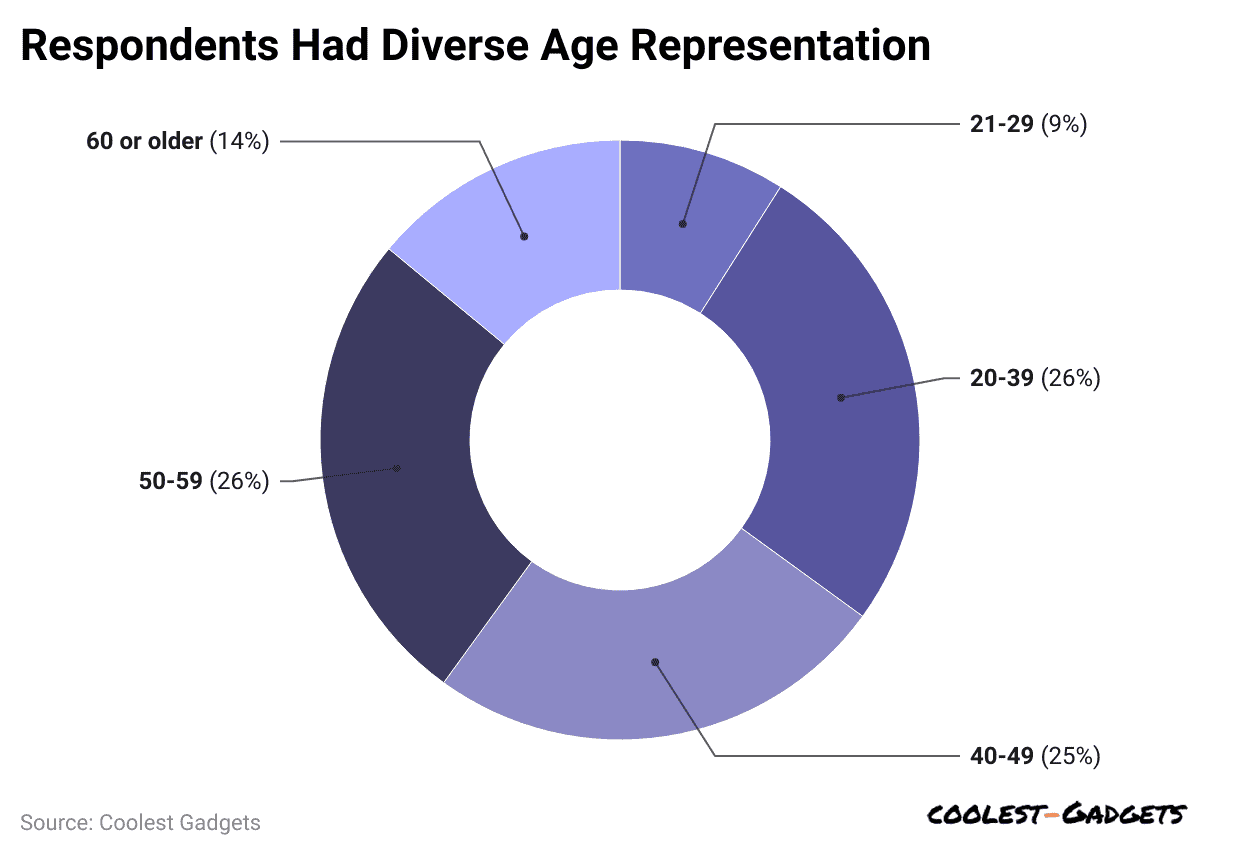 (Reference: agentsofchangeprep.com)
(Reference: agentsofchangeprep.com)
- Some were frontline managers (9%), senior managers (2%), social work assistants (1.2%), or social work students (1%), with around 1% selecting “other” or not specifying their roles.
- Regarding their work specialities, 33% worked in child protection, 22% supported older adults or those with mental health problems like dementia, and 14% worked with children in care (LAC).
- Social Worker Burnout Statistics stated that social workers in child welfare often experience burnout and high turnover because of a lack of support, which leads to isolation and mental health struggles.
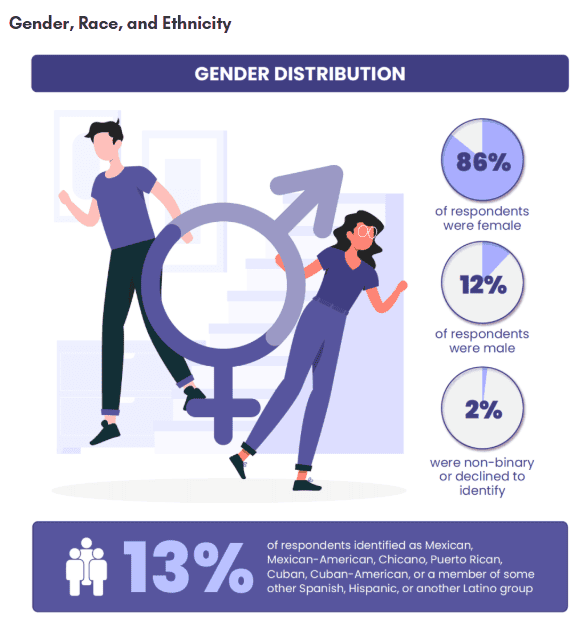 (Source: agentsofchangeprep.com)
(Source: agentsofchangeprep.com)
- When it comes to how long people have been in their jobs, 46% of social workers have been in their current positions for less than three years, while 54% have been in their roles for more than three years.
- Social Worker Burnout Statistics stated that most participants (94%) worked in government or public sector roles like local authorities, the NHS, or government positions.
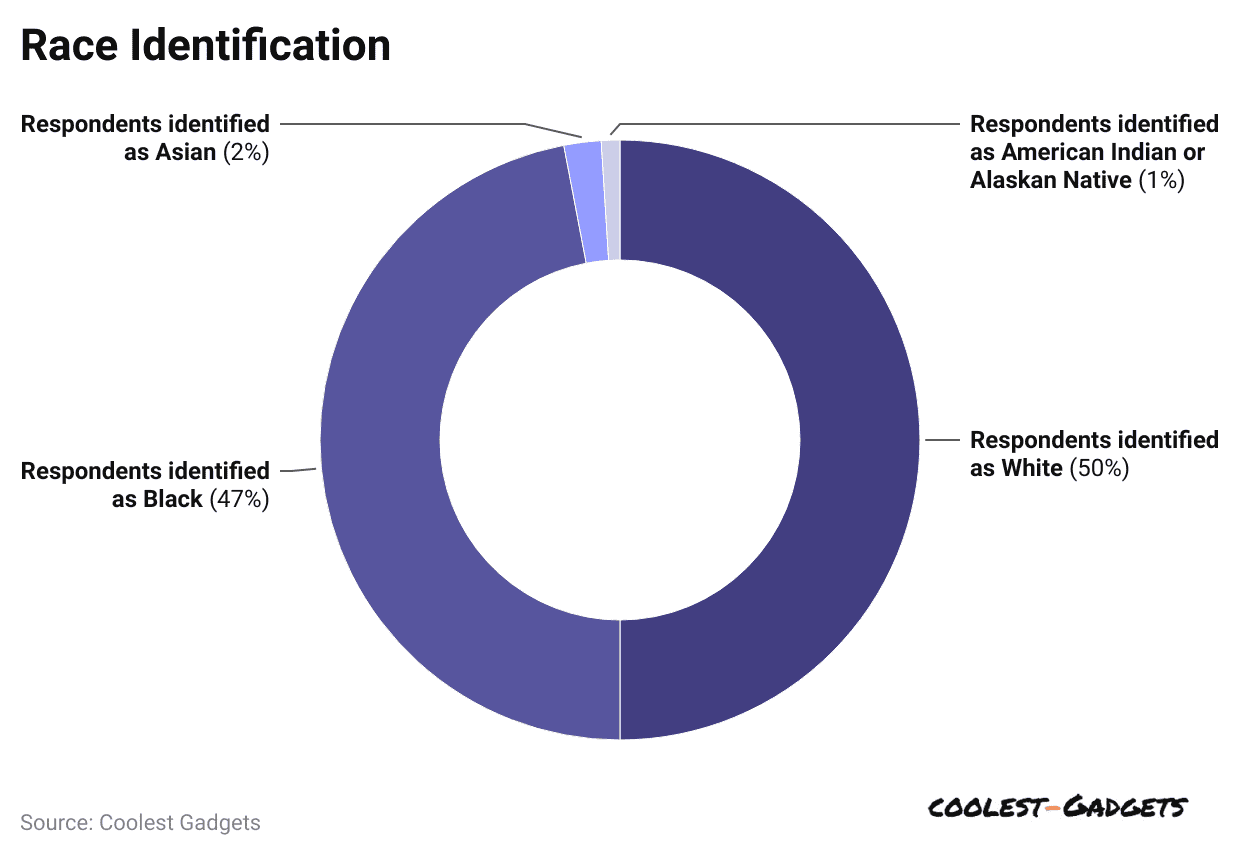 (Reference: agentsofchangeprep.com)
(Reference: agentsofchangeprep.com)
- As for emotional exhaustion, 73% of participants reported high levels, and 18% reported moderate levels.
- This means 91% of social workers felt at least some emotional exhaustion. When it comes to depersonalization, 26% had high levels, and 35% had moderate levels, meaning 61% experienced some level of detachment.
Conclusion
In conclusion, burnout among social workers is a serious and common problem that affects many professionals in the field. Over 70% of social workers feel emotionally exhausted, and a large number also feel disconnected from their work. These issues are mainly caused by heavy workloads, a lack of support, and the difficult nature of the cases they manage.
To help reduce burnout, it’s important to provide social workers with better support, more resources, and a healthier work-life balance. This way, social workers can continue to help those in need while also taking care of their well-being. We have shed enough light on Social Worker Burnout Statistics through this article.
Sources
FAQ.
Recent research shows a troubling rise in burnout among social workers. One study found that 75% of social workers have dealt with burnout at some point in their careers. During the COVID-19 pandemic, 41.2% of social workers reported experiencing severe burnout.
Burnout and stress in social workers are mainly caused by not having enough staff, heavy workloads, poor management, lack of support, limited chances to improve skills, and the negative way the public sees their job.
“The most difficult part for me is managing the emotional stress while also trying to meet tight deadlines, like finishing notes, getting in touch with people, and seeing each child. It can be a lot to handle and very stressful.”

Rohan Jambhale is a senior editor at Coolest Gadgets. He focuses on digital marketing, SEO, and social media optimization. Rohan excels at creating and editing detailed articles, ensuring they are accurate and valuable. He carefully reviews content from various writers before publishing and designs infographics to make statistics clear and engaging. His dedication ensures Coolest Gadgets delivers top-notch content to its readers.


